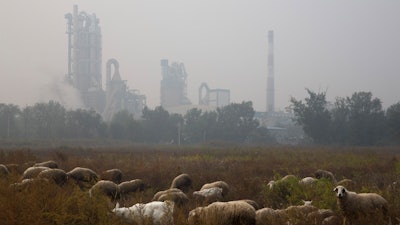
Heat trapping carbon dioxide emissions from making cement, a less talked about but major source of carbon pollution, have doubled in the last 20 years, new global data shows.
In 2021, worldwide emissions from making cement for buildings, roads and other infrastructure hit nearly 2.9 billion tons (2.6 billion metric tons) of carbon dioxide, which is more than 7% of the global carbon emissions, according to emissions scientist Robbie Andrew of Norway’s CICERO Center for International Climate Research and the Global Carbon Project. Twenty years ago, in 2002, cement emissions were some 1.4 billion tons (1.2 billion metric tons) of carbon dioxide.
Driven by China, global cement emissions globally have more than tripled since 1992, recently growing at a rate of 2.6% a year. It’s not just that more cement is being made and used. At a time when all industries are supposed to be cleaning up their processes, cement has actually been going in the opposite direction. The carbon intensity of cement — how much pollution is emitted per ton — has increased 9.3% from 2015 to 2020, primarily because of China, according to the International Energy Agency.
“Cement emission have grown faster than most other carbon sources,” said Stanford University climate scientist Rob Jackson, who leads Global Carbon Project, a group of scientists that track worldwide climate pollution and publish their work in peer reviewed journals. “Cement emissions were also unusual in that they never dropped during COVID. They didn’t grow as much, but they never declined the way oil, gas and coal did. Honestly, I think it’s because the Chinese economy never really shut down completely.”
Cement is unusual compared to other major materials, such as steel, because not only does it require a lot of heat to make, which causes emissions, but the chemical process of making cement itself produces a lot of carbon dioxide, the major human-caused long-term heat-trapping gas.
The recipe for cement requires lots of a key ingredient called clinker, the crumbly binding agent in the entire mixture. Clinker is made when limestone, calcium carbonate, is taken out of the ground and heated to 2700 to 2800 degrees (1480 to 1540 degrees Celsius) to turn it into calcium oxide. But that process strips carbon dioxide out of the limestone and it goes into the air, Andrew said.
Rick Bohan, senior vice president for sustainability at the industry group Portland Cement Association, said, “in the U.S., 60% of our CO2 is a chemical fact of life... The reality is concrete is a universal building material. There is no single construction project that doesn’t use some amount of concrete in it.”
Cement, which is the key ingredient in concrete, is in buildings, roads and bridges.
“Each person on the planet is consuming on average more than a kilogram (2.2 pounds) of cement per day,” said University of California Earth systems scientist Steve Davis. “Obviously, you’re not going to, you know, Home Depot and buying a sack of cement every day. But on your behalf, the roads and buildings and bridges out there are using more than a kilogram. And that’s kind of mind boggling to me.”
Even though there are greener ways to make cement, cutting its emissions dramatically is so difficult and requires such a massive change in infrastructure and the way of doing business, the International Energy Agency doesn’t envision the cement industry getting to zero carbon emissions by 2050. Instead there will still be emissions from cement, steel and aviation that need to be balanced out with negative emissions elsewhere, said IEA researchers Tiffany Voss and Peter Levi.
“These are hard, hard to cut,” Andrew said.
But industry’s Bohan said his group is certain that they can get to net zero carbon emissions by 2050, if it gets help from governments and especially cement users to accept and use green cement properly. One of several ways to make greener cement is to mix in fly ash, which is a waste product from burning coal, in place of some of the clinker and he said there’s more than enough fly ash available even with coal use reductions.
IEA’s Voss said the switch to green cement “is not there yet” because of technology, infrastructure and other concerns. But many in and outside the industry are working on the problem.
China is key because it produced more than half of the world’s cement emissions in 2021, with India a distant second at about 9%, Andrew’s data shows. The United States spewed 2.5% of the emissions from cement, ranking fifth behind Vietnam and Turkey.
“China is a huge country and its development ramped up,” Andrew said. “It’s driven everything.”
China is not just making and using more cement, but the carbon intensity has been going up a lot lately, IEA’s Voss said. That’s because earlier in its development, China was using cheaper, weaker low-clinker cement and buildings and bridges were collapsing, so now the Chinese government is mandating stronger cement, Norway’s Andrew said.
That’s a reasonable conservatism that slows efforts at making greener cement, Davis said. People are not eager to try untested cement recipes because “these are the structural materials of our society,” he said.
For example, Portland limestone cement has 10% less emissions but customers are so worried about strength they often say they are only willing to use it if they use 10% more, industry’s Bohan said.
Different cement uses have specific needs, such as strength versus longevity but users often just want the strongest and most durable when they don’t need it and this causes unnecessary emissions, Bohan said.
And while people talk about curtailing flying, global aviation emissions are less than half of that coming from concrete, according to Global Carbon Project. There’s “flight shaming” among scientists and activists, but no building shaming, Davis said.
Cement as it ages does suck some carbon dioxide out of the air, just like trees do, in small measurable, significant amounts, Jackson said.
“Our primary focus needs to be on fossil fuel use because that’s where most emissions come from,” Stanford's Jackson said. “I don’t think cement is on most policymakers' radar.”
Perhaps not on most, but it is on some. California, Colorado, New Jersey and New York have all passed legislation on cleaner concrete and the trend is growing.






















